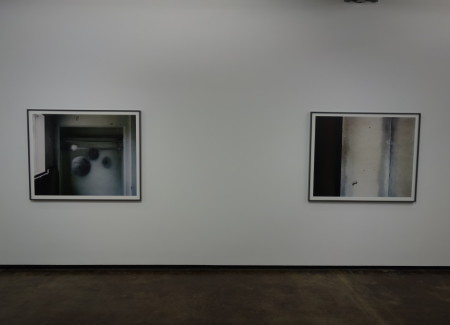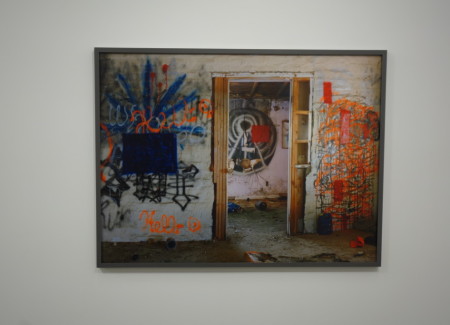JTF (just the facts): A total of 12 large scale color photographs, framed in grey and unmatted, and hung against white walls in the open, two room gallery space. All of the works are pigment prints on rag paper, mounted on Dibond. The 5 works from the Intervention and Dark Star series were made in 2007, are each sized 40×50, and are available in editions of 3. The 7 works from Theodore Street Project were made in 2010 and 2012; these prints range in size from 30×60 to 48×92/46×96 and are available in editions of 5. (Installation shots below.)
Comments/Context: Long before the current vogue for set building and in-studio construction took hold in contemporary photography, John Divola was thinking about the implications of deliberately making things to be photographed. Using the abandoned houses and dilapidated structures of Southern California as his playground, he explored active mark making, gestural abstraction, site-specific spatial intervention, and the consequences of past incidents and their evidentiary remains, making allusions to the prevalent conceptualism of those times, but doing so with an active, engaged physicality. His Vandalism series from 1973-1975 started with the application of interior-focused painterly squiggles, spirals, and dots in black and white, and was quickly followed by his Zuma series in 1977-1978, which not only transitioned to vibrant, ecstatic color, but also made a conscious effort to use the leftover, often charred architecture of the houses to frame the pastel sunset views of the sea outside. Both projects have become deserving cornerstones of his long photographic career (as smartly summarized in his recent three venue SoCal retrospective John Divola: As Far As I Could Get).
After spending a long stretch of time away from the seductive charms of falling down buildings, in the past decade, Divola has returned to the scene of the crime so to speak, reconsidering once again some of the ideas that got him started. In his Dark Star series (from 2008), he went back inside empty bedrooms and broken homes, this time painting large black circles on the bare walls and inside closets. And while there is an echo of Divola’s earlier work in these more recent interventions, the intentions are different – the floating orbs draw singular attention to themselves (rather than being all over pattern), becoming absorbing textural exercises, the minute reflections of light and cracks of the paint coming to the forefront and sucking us into the void. They seem more rooted in a specific instant in time than the earlier pictures, reveling in the details of enveloping blackness, rippled glare, silvery reflection, and underlying surface.
Divola’s newest works revisit the exact same decaying location that hosted the Dark Star images, but in the intervening years, his isolated forms and reductive geometries have been covered in layers of additional graffiti contributed by other unknown authors, and the rooms have become littered with leftover debris. His once pared down exercises are now drowning in a chaotic sea of stylized tags, pictograms, random sprays, and shouting slogans, from Kill Whitie! and Revolution with Guns to the more universal Hello and Fuck All U. Seen with the earlier pieces, there is a sense of conceptual inversion, where Divola’s reserved interventions are being overwhelmed by the heated violence of other performative additions, the academic rigor competing with and ultimate being buried by loosely brash emotion.
While the Dark Star images were taken with an 8×10 view camera, cropping the space down to the formal centrality of the black circles, the Theodore Street photographs step back and take in the whole ragged scene, using a Gigapan scanning device originally developed by NASA for the Mars Rover. This device scans the environment from edge to edge, taking 120 individual frames and then compositing them into a single large scale image. Given the sweep and turn of the robotic lens, the results often have a rounded, almost panorama-like distortion, but are sharp at nearly all depths – the pictures almost feel three dimensional in their intense clarity, allowing us to unpack the sedimentary layers of spray paint with painstaking fidelity. (This camera was also used for a pair of wide view exterior landscapes of the abandoned house, documenting the ugly sweep of dry overgrown scrub and greying vegetation that surrounds the structure.)
Since there is some elapsed time as the camera cycles through its grid, Divola has inserted himself here and there. While a stray hand or arm was often part of his original 1970s interventions, this time his presence is freighted with more intent, his body always largely obscured by the walls of the space, but resolutely part of the evidence, the “I am here” impulse of most graffiti given a nuanced performative physicality.
On their own, the Theodore Street pictures feel tech-heavy – they’re cool because of their unusual engineering approach, but didn’t resonate for me as stand alone documentary records of abandonment. But when they are paired with the elegant Dark Star orbs, and we can see the tangible progression from one to the other (a black circle in one, the same black circle tagged and overwritten in another), the notions of elapsed time and the step-by-step laying down of artistic incidents and interventions become clearer. It’s that community of active destruction that Divola has been a participant in that feels rich and layered, his measured thoughtfulness forced to compete with its arbitrary impulsiveness. His acknowledgement of that surrounding activity and his intentional engagement with it are what’s exciting here – it gives the images a fresh dynamism and a path forward.
Collector’s POV: The works in this show are primarily being sold as a complete series, priced at $240000. On an individual basis, the prints range in price from $20000 to $35000, based on size. Divola’s work has only been intermittently available at auction in recent years. Prices have generally ranged between $1000 and $10000, but these few data points may not be particularly representative of the actual market for his work.












